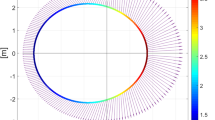The application of four light pressure models, including the standard model, two empirical models with different degrees of complexity, and physical-empirical model taking into account the optical properties of the spacecraft (SC) surface for prediction of SC motion and determination of its orbits is analyzed. The accuracy of these models used to determine the orbits of the GLONASS satellite system and the stability of the model parameters are estimated.
Similar content being viewed by others
References
C. J. Rodriguez-Solano, U. Hugentobler, and P. Steigenberger, Adv. Space Res., 49, 1113–1128 (2012).
I. S. Gayazov, Application of high-precision observation of geodetic and navigation artificial satellites for solving problems of geodynamics, Doctoral Thesis in Physical and Mathematical Sciences, Russian State Library, Saint Petersburg (2006).
IERS Standarts, IERS Technical Note, Central Bureau of IERS, Paris (1992).
D. Vokrouhlicky, P. Farinella, and F. Mignard, Astron. Astrophys., 307, No. 2, 635–644 (1996).
Ya. É. Helali, Yu. V. Batrakov, and A. M. Fominov, Trudy Inst. Prikl. Astron. RAN, No. 4, 300–309 (1999).
The International GNSS Service (2013), Mode of access: http://ig scb.jpl.nasa.gov/(10.26.2014).
G. Petit and B. Luzum, eds., IERS Conventions (2010), IERS Technical Note 36, Frankfurt am Main (2010).
Lunar Prospector Spherical Harmonics and Gravity Models 2006. URL: http://pdsgeosciences. wustl.edu/missions/lunarp/shad (December 7, 2010).
V. A. Brumberg and T. V. Ivanova, Celest. Mech. Dyn. Astron., 97, 189–210 (2007).
D. Vokrouhlicky, P. Farinella, and F. Mignard, Astron. Astrophys., 290, 32 (1993).
A. Milani, A. M. Nobili, and P. Farinella, Non-Gravitational Perturbations and Satellite Geodesy, Bristol (1987).
H. Fliegel, T. Gallini, and E. Swift, J. Geophys. Res. 97 (B1), 559–568 (1992).
A. G. Aleksandrova and I. N. Chuvashov, in: Proc. IXth All-Russian Conf. on Fundamental and Applied Problems of Modern Mechanics, Tomsk (2016), pp. 331–333.
A. G. Aleksandrova, I. N. Chuvashov, and T. V. Bordovitsyna, in: Proc. IXth All-Russian Conf. on Fundamental and Applied Problems of Modern Mechanics, Tomsk (2016), pp. 328–330.
Author information
Authors and Affiliations
Corresponding author
Additional information
Translated from Izvestiya Vysshikh Uchebnykh Zavedenii, Fizika, No. 2, pp. 117–122, February, 2017.
Rights and permissions
About this article
Cite this article
Aleksandrova, A.G., Chuvashov, I.N. Choice of the Effective Light Pressure Model for Glonass Satellites. Russ Phys J 60, 331–338 (2017). https://doi.org/10.1007/s11182-017-1079-6
Received:
Published:
Issue Date:
DOI: https://doi.org/10.1007/s11182-017-1079-6



